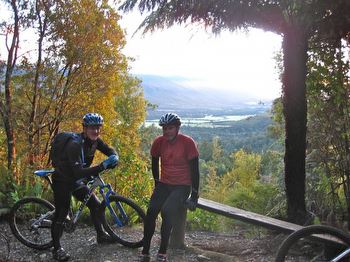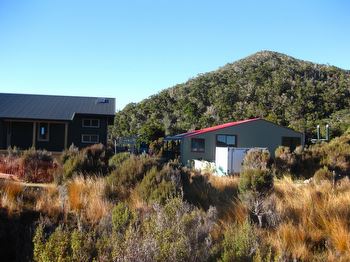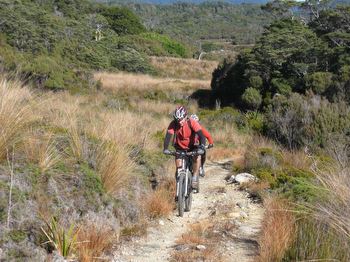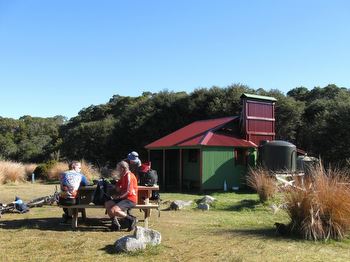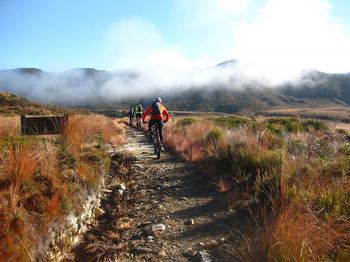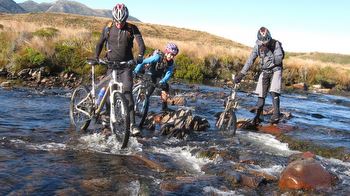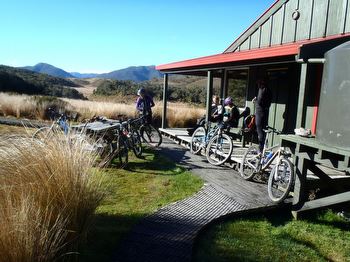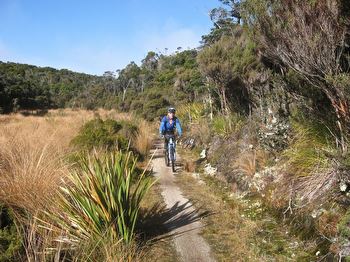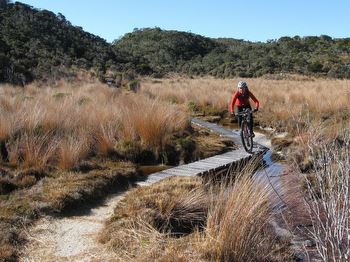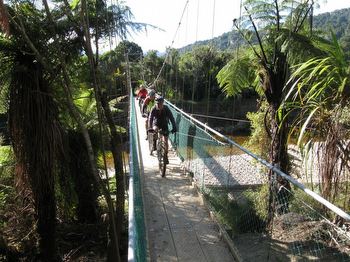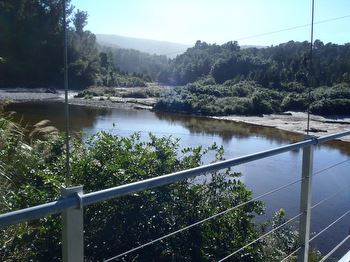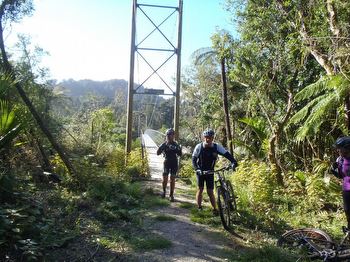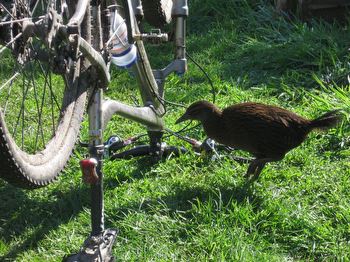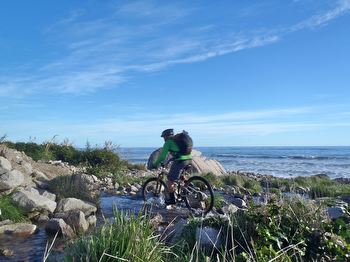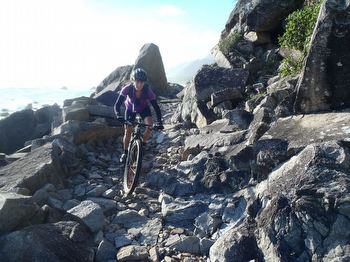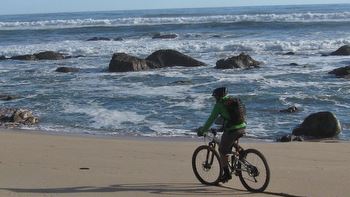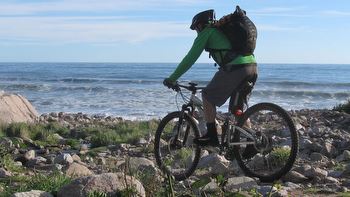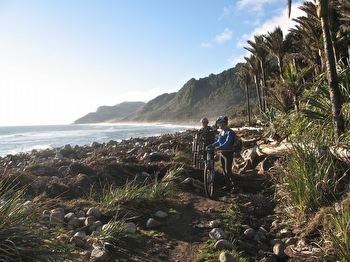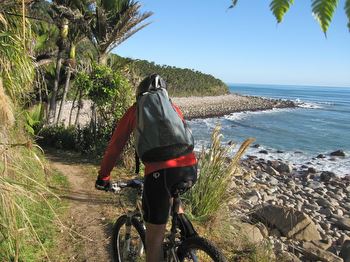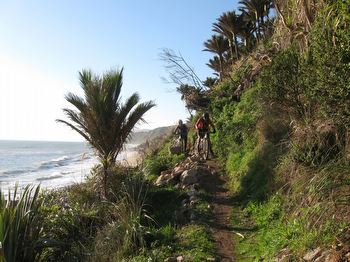
There’s a hell of a lot to think about when doing this ride and we seriously recommend you plan your trip well, as 78.4 kilometres across remote mountains with a reputation for extreme weather is nothing to be taken lightly.
Disclaimer The information and advice below is based on the experiences of a group of mountain bikers riding the Heaphy Track there and back (Aorere -> James Mackay Hut -> Karamea -> James Mackay Hut -> Aorere) over four days and a group riding riding Aorere-> Karamea in one day and returning 2 days later, again in one day. It will be influenced by their experience, fitness, ages, skills, attitude, bikes, gear, general outlook on life and the weather during their ride. Adapt and adjust to suit yourself.
Number of Days
This is the first question for most riders. Many people are tempted to ride the 78 kilometre track in a single day. To do this you will need to be uber fit, very experienced and able to postpone if the weather is looking even slightly dodgy. The one day group sent their overnight gear by shuttle or courier to Karamea. If doing the return trip as well, you are advised to spend a day enjoying the pleasures of Karamea as your bike will need a good check over and your butt and legs will thank you for a day off. Include spare tyres, chains etc in your luggage. You may not need them but you’ll be very happy if you do. For the two day option you can sleep overnight in Saxon Hut or James Mackay Hut, roughly splitting the ride in two. However you will need more gear and food (see below). Two days will be a lot more manageable for most people and seems like the most popular option.
Some groups take a leisurely three day approach - riding from Aorere to Perry Saddle Hut on the first day, the Heaphy Hut on the second, and out to Karamea on the third. This makes for a 45 kilometre middle day with 2 half days. An option for experienced and fit riders has been to ride to Mackay Hut on day one, leave gear there, then ride out to Kohaihai at the Karamea end and back to Mackay in one day. This has also been done in reverse, starting at the Karamea end, which better suits riders from south of Nelson. Coming from the south Saxon Hut could be the overnight stop. This option makes transport easy. Another option is to day trip in from either end of the track. E.g. from Brown Hut to Saxon or Mackay and return or from Kohaihai to Lewis or Mackay and return. This way you’ve no overnight gear to carry and you can turn back when you’ve gone as far as time allows. Whatever you plan for give yourself plenty of leeway to finish later (yes, even a day or two later) than expected. The Heaphy area is prone to flooding and it is not uncommon for people to get trapped by rising rivers.
Direction to Ride
The track is rideable in both directions. However, if you are going to do it one way we all agreed the Aorere to Karamea direction was more enjoyable track. The section from James Mackay Hut to Lewis Hut is a super fun singletrack downhill and made the ride for many of us. Riding up it just isn’t the same although it is an easy grade. The ride down from Perry Saddle to Brown Hut isn’t particularly enjoyable as the track is quite rough, even on a full suspension rig.
Group Size
One of the requirements for mountain bikers being allowed to ride the Heaphy Track is a maximum group size of six. A group of 3 or 4 is ideal as you can move more quickly if necessary and there are fewer people to have problems. Taking the weather and possibility of bike failure and/or injury into account riding solo would be foolish and a group of 3 or more would be ideal.
Weather
The Heaphy is only open to mountain bikers from May through to September, which happily coincides with the depths of winter. Now for the good news - the weather in the Heaphy area is famous for its ability to change from mild to wild in the blink of an eye, all year round. To put this in perspective in December 2010 the Aorere River on the Northeast side of the Heaphy was flowing at 3.5 million litres of water per second - a hundredfold increase which flooded the Aorere Valley washing away road bridges, livestock and damaging housing. Large sections of the Heaphy Track would have been under a metre of water with dozens of creeks, streams and rivers impassable. And that was summer. So please, please, please, whatever you’re planning - keep in mind you, your bike and everything you have are probably going to get very, very wet. Bikes We had a real mixture of bikes from a drop bar fully rigid Salsa Fargo touring bike to a single chainring Santa Cruz Nomad. It is always difficult to quantify what makes a decent bike, but the following will hold true for anything with two wheels. Rim brakes will wear out in the wet gritty terrain, disc brakes are recommended. Drive trains also wear out in wet gritty terrain, make sure yours isn’t too worn before you start. Forks will fill up with water if they aren’t properly sealed, if you’re unsure get them checked by a qualified mechanic before you start. As a general rule any well serviced bike with X7/ Deore/ LX/ SLX components or above should do the job. Full suspension definitely has its benefits over the numerous long rocky sections, but we had 4 guys on hardtails and they all had the time of their lives. The group doing the one day each way found it worthwhile to wash their drivetrains at either Heaphy or Lewis Hut and lube their chains if necessary to get the sand and grit out. It paid off with no chain suck.
Baggage
The two most popular setups were either putting everything into a good riding backpack, or riding with a rear rack and a dry bag. Half of us were using New Zealand designed Freeload racks on our bikes, these fit on almost all full suspension bikes and were great for bulky gear like sleeping bags and extra clothing. Dry bags take a battering from the elements and swing bridge crossings, it’s definitely worth investing in a heavy duty dry bag over the lighter nylon ones. Most of our nylon dry bags had holed by the end of the trip. Side panniers will be an absolute nightmare on some of the swingbridge crossings and require multiple trips. If it rains it would be very difficult to keep side panniers out of creeks/ flooded sections. And they generally suck for riding sweet singletrack. Almost everyone rode with most of the weight on their backs. As a proviso one of our riders found his pack too large and bulky and it literally wore him out over the first crossing of the Heaphy. The best advice is to make a gear list and test it in anger.
Getting There
The Aorere end of the Heaphy Track is approximately 2.5 hours drive from Nelson. The final 13 kilometres are gravel and there were three ford crossings which became impassable after heavy rain. These have now been bridged. The Karamea end of the Heaphy Track is 17km from Karamea, some of which is gravel. It wouldn’t be a bad bike ride, but as you’ve come out of some of the best singletrack in the country an hour of on-road grind might put a dampener on things. Karamea Express does picks up from the road end and there is a phone at Kohaihai you can use to call them. A number of services are setup to supply transport. Some options are: Getting a friend to drive your vehicle around (6-7 hour drive from Aorere to Karamea) Have two groups start from either end and key swap in the middle. A number of companies offer a minibus shuttle service; fixed wing aircraft from Karamea to Takaka; helicopter from Karamea to Takaka. The only company we had dealings with was Karamea Express who we can heartily recommend. They have a special bike trailer and Dave the owner is a great guy to deal with. Karamea
As mentioned the ideal riding direction is Aorere to Karamea. The Last Resort offers beds, showers, laundry, cooked meals, bar food, beverages, internet, bike washing facilities, friendly service, and pretty much anything else weary, smell mountain bikers would want. We also found it surprisingly cheap with $100-130 covering an excellent dinner, dessert, bar food, drinks, cooked breakfast, laundry and a comfy bed for the night. Rooms have linen, towels and soap, so you don’t need to worry about those. The Karamea Village Hotel also has self contained units at a reasonable price and good meals. The 4 Square at Karamea has a good range of food, including lots of riding/ tramping food. There’s a post office, a couple of farm supply shops and a pub. Fuel at the service station cost around 15 cents more a litre than city prices as of May 2011.
Daylight
Keep in mind that as the Heaphy Track is only open from May to September you’re going to be dealing with limited daylight. At the start of May there was a bit over 9 hours of light and then things get grey, murky and very, very dark. In mid-June there is even less daylight especially in the bush. One of the requirements for mountain bikers on the Heaphy is no night riding (you may bowl a kiwi) so again, plan your days around what you can realistically achieve during the hours of daylight with some leeway in case something goes horribly wrong. The following times between huts were recorded by the one day group. They were not encumbered by overnight gear and the track was in excellent condition so don’t expect to match these times, but use it as a relative guide only. If you are attempting to ride through in one day you must be capable of achieving these times with minimal stops or you ain’t gonna make it.
Times are from north to south with south to north in brackets.
Brown Hut to Perry Saddle Hut 2h 10m (1h 10m) If you don’t make Perry in this time you are too slow, so can it if you are trying for a 1 dayer.
Perry Saddle Hut to Gouland Downs Hut 30mins (55mins)
Gouland Downs Hut to Saxon Hut 30 mins (23mins)
Saxon Hut to Mackay Hut 1h 05m (1h 15m)
Mackay Hut to Lewis Hut 1h (1h 57m)
Lewis Hut to Heaphy Hut 40 mins (40 mins)
Heaphy Hut to Kohaihai 1h 40m (1h 45m)
Kohaihai to Karamea 50mins (50mins)
Huts
All the huts must be booked in advance. They all have outdoor toilets, water on tap, a heat source (wood/coal fire) and range tops for cooking. The bedding are simple foam mattresses. Many of the huts have uncovered bike racks, you’re not allowed to bring you bike onto the hut verandas. Please respect other users and tidy up after yourselves. Swingbridges
There’s a few old style swingbridges on the track. Depending on the river levels some (but not all) of them can be avoided by fording instead. The old style bridges are narrow and made of steel rope, which plays havoc with a person and a bicycle. The best approach was to either carry the bike above your shoulder, or wheel it on its rear wheel ahead of you. A number of riders get snagged by the bridges and some clothing/ dry bags get ripped. As only one person can use a bridge at a time, and some of them are quite long expect a wait (a couple of minutes per person). Especially if there is a number of riding groups on the trail. The good news is DOC is upgrading most of these bridges to the new wooden style which are rideable. Gunner, Swanburn and Heaphy have been done.
Gear
3/4 season sleeping bags get too hot for a well heated hut. Chain lube is essential to keep your bike going forward. Pack insect repellent, the sandflies on the Karamea side are voracious. Earplugs, pegs, matches, lighters and candles are worth their weight in gold at huts. Double or even triple bag everything you want to keep dry. Try and organise a full set of clothing and shoes for the end of the ride. An emergency rescue beacon is damn good insurance. We had a SPOT Tracker which can act as an emergency beacon. Please take some spare mountain bike magazines in to leave at the huts. The current reading material is dire. Food You will be burning up massive amounts of energy so take edible things that are energy dense, nutritious, and easy to carry. For dinner most of us used Back Country dehydrated meals or Kaweka boil-in-a-bag meals. The Back Country meals are around 95 grams while the Kaweka are more like 380 grams but taste a lot nicer. Absolute Wilderness is a new brand on the market that is both light and tasty. At the end of the day it doesn’t matter what sort of food you take, just make sure you have more than enough. If you get holed up in a hut surrounded by flooding rivers it’s nice to have enough food to last you until the river level drops. On that note don’t eat everything you have on the last night, it may not be your last night. Water In case you hadn’t guessed there is water everywhere. Even if it’s not raining there are plenty of creeks and each hut has a water supply on tap you can theoretically drink without boiling.
Keas and Wekas
The local keas (large alpine parrots) discovered bike saddles on the 2 May 2011. They may think it’s funny to tear them to shreds. There have also been reports of grips and hydraulics lines receiving the beak treatment. We took our seatposts out of the bikes at James Mackay Hut and hid them. Keas will have a go at pretty much anything, so be warned. Wekas are prone to running off with anything that isn’t tied down, especially if it’s shiny. Be Prepared Not only is the mid-point of the track 40 kilometres from any road, but it’s 60ish kilometres from civilisation. The Heaphy Track is a back country ride and if you aren’t experienced looking after yourself in the middle of nowhere make sure at least one member of your group is, and follow their lead. We took lots of gear, first aid, a cooker, survival blankets and a SPOT Tracker (which can act as an emergency beacon). There are DOC rangers about, but they won’t be at every hut so don’t rely on finding one easily. If all else fails and you do manage to get a rescue chopper in, it will be coming for the people, they won’t take bikes. Don’t Be Cheap By this we mean two things: Don’t scrimp on your bike preparation or gear. If you can’t afford the proper gear then borrow it. If you can’t borrow the gear then don’t do the Heaphy Track until you’re properly prepared. We’ve heard some horror stories from the 90s of mountain bikers trying to get through on shitty bikes with their normal sea level riding gear. You will get up to 900 metres above sea level so it can be cold any time of the year. The success of mountain bikes on the Heaphy Track partially relies on the benefit to the communities the Heaphy supports. Both Golden Bay and Karamea are quiet over winter and an injection of mountain biker cash for food, beer and accommodation will do wonders to their local economies. So spend a night or two there to enjoy their hospitality, you’ll be glad you did.
